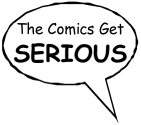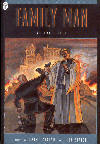

| Family Man. Book 1: To Protect and Serve. Written by Jerome Charyn. Illustrated by Joe Staton. New York: Paradox Press/DC Comics, 1995. 94p. (Paradox Mystery). $4.95. |

|
GENRES: AUDIENCE: SYNOPSIS: Back at his apartment, Alonzo finds Alice, his brother's lover. She has brought him a cat for company, and Alonzo grudgingly accepts it. As Alice makes her way home, she's accosted by lecherous men, but the very presence of the Monsignor makes them run away. The Monsignor meets with the beleaguered Police Captain, who urges the Monsignor to rein in his brother, whose perceived threat is that he could stir up the Mafia. Meanwhile, Alonzo meets with a mob lawyer-turned-respectable, Harvey, to see if he knows anything about the assassinations, but Harvey is also ignorant--and fearful of getting involved again. Leaving Harvey's office, Alonzo is set upon by three former cops, who drag him off and start digging a grave for him. But they're stopped by the Monsignor--they're his henchmen, and he had only asked them to bring Alonzo to him. The Monsignor insists that Alonzo stay in his apartment under unofficial house arrest. Later, the Monsignor goes with the mayor to give a speech to rich people at the Pioneer Club. Afterwards, he's "introduced" to Roger and Heloise Abelard, a brother and sister who loathe one another. He actually knows Roger well; they have plans and secrets together, and Roger finances the Monsignor's activities. Roger even asks the Monsignor to kill Heloise, but the Monsignor refuses. Afterwards, the Monsignor takes his three ex-cops and grabs Don Furioso, presumably for the bounty on his head. But as they're leaving, Alonzo confronts them. He and his brother exchange angry words, and Alonzo leaves with his Don, who hints that the Monsignor might have murdered Alonzo's wife and children. Alonzo contacts the few remaining Mafia-related individuals, looking for a safe place for the Don, but no one is willing to take him for more than a day. Then he goes back to Alice and asks her point-blank if the Monsignor murdered his wife and children. She can't believe he would say such a thing. Elsewhere, the Monsignor meets with a roomful of people whom he has under his sway. He urges them to take revenge on "the mayor and all his freeloaders." The room empties to reveal Heloise; she has obviously been working with the Monsignor for some time. On the streets, some ex-cops attack a street person pushing a shopping cart; the person turns out to be Alonzo, and he fends them off and takes their money. He looks in on Blind Henry, the man with whom he left the Don, to find the Don gone and Henry dead. The killers are the Monsignor and his henchmen, and the book ends as they shoot Alonzo. EVALUATION: As the main character, Alonzo is too low-key, despite his drive to be a good family man. He should have been something like the Bruce Wayne of Batman: Beyond, loaded with powerful dignity and obsession, but he's more like a sleepwalker going through the motions. The Monsignor had some potential, but turning him into the leader of a fanatical cult was a cheap (and cliched) way of making him threatening. The rest of the characters are little more than ciphers. Granted, this is one book of three, but a writer of Charyn's experience should have been able to build strong characters right from the start. The story is not well served by Staton's pencil art, which is not suited to a non-superhero story such as this. It looks like he was trying to emulate Will Eisner, but he's a pale imitation of the Master, with his unreasonably powerful-looking men; endless head shots of grim, tight-lipped people; and uninspired camera angles. Continuing the old Bruce Wayne parallel, Alonzo is an almost inhuman fighter; he disarms an approaching thug without hardly moving, and he easily bests groups of people in combat. Is this a semi-superhero title after all? This impression is furthered during a weird scene with the Monsignor. He sweeps his robes around a man who was hassling Alice--and the man apparently vanishes! What the heck?!? Is the Monsignor code-named "Cloak"? Why would the Monsignor do something stupid like that anyway? (Was he going to fart at him or something? And what if the guy grabbed his crotch?) And how the hell can the Monsignor and Alice kiss face-to-face with this guy still under the Monsignor's robes? In the absence of the other books and any real indication that this title is actually a fantasy, I can only conclude that this is an incredibly poorly thought out scene--the kind of clumsy sequential art that tends to be overlooked in superhero comics but that shows a painful naivete in more realistic titles.
Overall, a weak work that could stand as a symbol of how the Big Two have been unable to accommodate a mainstream audience. Of interest only to Charyn and Staton completists. I suppose it could be considered as a historical document of a failed experiment, but who wants to collect or read those? |
||||||
Return to Rational Magic Home
